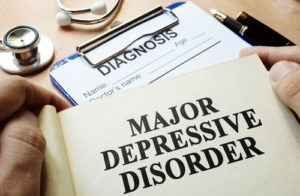
Did you receive a denial after applying for persistent depressive disorder veterans’ benefits? You can appeal the denial. Get help from a veterans’ disability advocate.
Call (888) 373-4722 for a free consultation.
Getting VA Disability Benefits for Persistent Depressive Disorder
Persistent depressive disorder, also known as dysthymia, can rob you of your ability to work, socialize, maintain relationships, and enjoy the activities you once loved. Although it is less severe than a major depressive disorder, its symptoms are chronic and, as the condition’s name indicates, persistent, making daily living activities a challenge.
If your persistent depressive disorder resulted from a specific event during your military service or began when you were in the service, you can recover benefits from the U.S. Department of Veterans Affairs (VA).
Causes of Persistent Depressive Disorder
Doctors are not clear on the causes of persistent depressive disorder. Many believe it arises from a combination of factors, some genetic, others external. In some people, stressful or traumatic life events can trigger the condition, which may explain its prevalence among current and former service members. Often times it can also be brought about because of a physical disability that is impacting ones livelihood.
If you believe that your diagnosis of persistent depressive disorder began in service, is related to your service, or maybe even is because of a disability you are already service-connected for, a disability advocate can help you submit a VA disability appeal and collect benefits. For a free case evaluation, call (888) 373-4722.
The VA Disability Compensation Scale for Persistent Depressive Disorder
To determine your impairment for persistent depressive disorder, VA uses the following criteria:
100% Impairment Rating: “Total occupational and social impairment, due to such symptoms as: gross impairment in thought processes or communication; persistent delusions or hallucinations; grossly inappropriate behavior; persistent danger of hurting self or others; intermittent inability to perform activities of daily living (including maintenance of minimal personal hygiene); disorientation to time or place; memory loss for names of close relatives, own occupation, or own name.”
70% Impairment Rating: “Occupational and social impairment, with deficiencies in most areas, such as work, school, family relations, judgment, thinking, or mood, due to such symptoms as: suicidal ideation; obsessional rituals which interfere with routine activities; speech intermittently illogical, obscure, or irrelevant; near-continuous panic or depression affecting the ability to function independently, appropriately and effectively; impaired impulse control (such as unprovoked irritability with periods of violence); spatial disorientation; neglect of personal appearance and hygiene; difficulty in adapting to stressful circumstances (including work or a work-like setting); inability to establish and maintain effective relationships.”
50% Impairment Rating: “Occupational and social impairment with reduced reliability and productivity due to such symptoms as: flattened affect; circumstantial, circumlocutory, or stereotyped speech; panic attacks more than once a week; difficulty in understanding complex commands; impairment of short and long-term memory (e.g., retention of only highly learned material, forgetting to complete tasks); impaired judgment; impaired abstract thinking; disturbances of motivation and mood; difficulty in establishing and maintaining effective work and social relationships.”
30% Impairment Rating: “Occupational and social impairment with occasional decrease in work efficiency and intermittent periods of inability to perform occupational tasks (although generally functioning satisfactorily, with routine behavior, self-care, and conversation normal), due to such symptoms as: depressed mood, anxiety, suspiciousness, panic attacks (weekly or less often), chronic sleep impairment, mild memory loss (such as forgetting names, directions, recent events).”
10% Impairment Rating: “Occupational and social impairment due to mild or transient symptoms which decrease work efficiency and ability to perform occupational tasks only during periods of significant stress, or; symptoms controlled by continuous medication.”
0% Impairment Rating: “A mental condition has been formally diagnosed, but symptoms are not severe enough to interfere with occupational and social functioning or to require continuous medication.
As of December 2019, here are the VA disability compensations you can receive at each rating (for a single veteran with no dependents):
- 10 percent disability rating: $142.29 per month
- 30 percent disability rating: $435.69 per month
- 50 percent disability rating: $893.43 per month
- 70 percent disability rating: $1,426.17 per month
- 100 percent disability rating: $3,106.04 per month
An advocate will assist you with gathering evidence and submitting your appeal to help you not only get service-connected but also to get you the highest rating to which you are entitled. Get veterans’ disability help today. Call (888) 373-4722 for a free consultation.



